|
Buildings That Breathe:
Green Construction is Coming of Age
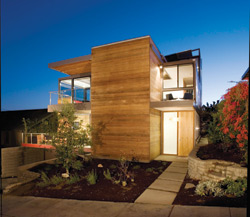
By Sally Deneen and Brian Howard
It is widely agreed that aquatic life and fisheries are in global decline. However, a new report says the damage could be worse than previously suspected. Appearing in Science, the report summarized a four-year study by a team of ecologists and economists, and concluded that at current rates of over-fishing almost all marine life harvested by humans will be wiped out before 2050.
Buildings are definitely energy hogs. The SUV is the environmental bad-boy symbol, but buildings consume more energy than cars and trucks. It’s estimated that commercial and residential buildings in the U.S. consume 65 percent of all electricity, as well as 12 percent of drinkable water and 40 percent of all raw materials, according to the Commission for Environmental Cooperation, an international organization that is expected in early 2008 to release a report evaluating green building in the U.S., Canada and Mexico.
“I believe that buildings are the worst thing that people do to the environment,” said Rob Watson, former senior scientist at Natural Resources Defense Council, on the Public Broadcasting System news show, NewsHour with Jim Lehrer, in 2005. “…[W]e don’t associate the fact that when we turn on a light switch, coal is mined in a mine. It goes to a power plant that comes up the stack as acid rain producing sulfur dioxide, planet-cooking carbon dioxide.”
“The new green building movement arises from the realization that we can’t go on living as we have in the past: that treating the environment in general and energy in particular as afterthoughts no longer makes sense,” author Bill McKibben wrote in an essay marking the October opening of New York City’s 46-story glass-and-steel Hearst Tower, which required 20 percent less steel than a conventional skyscraper and was made of 90 percent recycled material. Sensors there switch off lights when no one is in a room. “They’re sensible, cost-effective, obvious [measures]—someday they’ll be code. But for now they’re noble, pioneering examples.”
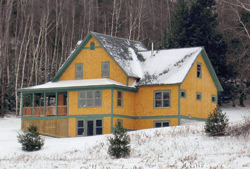
No Longer Straw Bales
The green building movement expands on the 1970s solar-energy craze, when drastic oil shortages spurred interest in sun-powered homes and President Jimmy Carter installed solar panels on the White House (later removed by Ronald Reagan). More than a million young people stoked on hippie idealism went “back to the land,” homesteading in rural cabins, often without running water or electricity... and most soon abandoned the discomforts and headed back to where they came from, Eleanor Agnew writes in her book Back From the Land. Interest waned. But by the early 1990s, the green building movement took off, broadening its focus to consider other issues such as the environmental impacts of materials and whether the buildings offer health benefits, according to Alex Wilson, president of Vermont-based BuildingGreen, executive editor of Environmental Building News and author of Your Green Home.
A number of cities around the country, including San Francisco (and neighboring Pleasanton, Berkeley and San Mateo), Boston, Seattle and Scottsdale, Arizona, are leading the way with laws that require new public buildings to be green. So far, 54 cities and 23 federal agencies have adopted LEED standards for buildings, says Bill Browning, senior fellow for Rocky Mountain Institute and co-author of Green Development: Integrating Ecology and Real Estate. An industry has blossomed around the concept. At least 12,000 people, a record, attended the GreenBuild International Conference and Expo in Denver last November.
Some committed folks still design homes that allow them to live off the grid, even in cities. More than 25,000 people have trekked to tiny Hopland, California since 1992 to attend the Solar Living Institute’s hands-on workshops on such things as building homes with baled straw.
But the broader green building trend has gone upscale—sometimes way upscale. In October, Arnold Schwarzenegger toured the rooftop solar panels of New York City’s first green residential tower, The Solaire, home to maid service, views of the Hudson River and Battery Park, plus a 24-hour concierge. Green oddities include toilets that flush with water treated in the same building. Fridges churn out doubly filtered drinking water. (Resident manager Michael Gubbins’ favorite things about his apartment are more basic: “the quality of fresh air and amount of natural daylight.”)
Three significant drivers are shifting landowners toward green buildings. One is rising, unstable energy prices. “What that means for building owners is they’re going to increasingly want homes and office buildings that protect themselves from high outlays of money for heating and cooling,” Wilson says.
Health is another driver. Americans spend 90 percent of their time indoors, where asthma and allergy attacks can be triggered by air pollutants whose levels may be two to five times higher than pollutants outside, if not more, according to the federal Environmental Protection Agency (EPA). William Fisk, head of the Indoor Environment Department at Lawrence Berkeley National Laboratory, has shown that improved ventilation systems reduce respiratory illness by nine to 20 percent, yielding a savings in the U.S. of $6 to $14 billion per year. Another benefit is faster recovery from illness, since views of the outdoors and connections to nature promote healing. In fact, it is partly for this reason that U.S. hospitals are becoming increasingly interested in green design. According to Wilson, the nation’s largest healthcare provider, Kaiser Permanente, has committed to a green building initiative.
The third driver: the environment and the feeling that people can do something to save the Earth. TV images of stranded Hurricane Katrina victims brought home the reality of what can happen due to human-influenced climate change. When Al Gore’s An Inconvenient Truth hit movie theaters, it made climate science accessible. People began to realize that they could be agents of change.
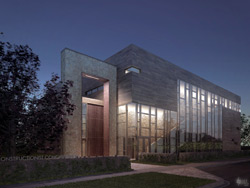
Building Smarter
Green construction often adds less than one percent to the cost of a conventional building, but the payoffs can include energy costs cut by one-third, says Gregory Kats, a principal with alternative energy advisors Capital E. Among buildings he’s studied, the typical payback is three to four years. To go with a conventional design these days is “financially riskier,” Kats says, “than building a healthy green building.”
Adding more eco-friendly features to a building can increase these costs. Achieving the Green Building Council’s highest design standard (“LEED Platinum”) may tack on five percent or more. The LEED rating system is a national, voluntary, consensus-based standard. The science-based approach emphasizes such factors as sustainable site development, water and energy efficiency, wise materials and indoor air quality. Using a point system, the more points a building earns, the higher its LEED ranking. There are four LEED rankings: basic certification, silver, gold and platinum.
It’s not the only green rating system. About two dozen others exist in specific geographical areas around the nation. But as a national program, LEED has emerged as a dominant player.
“You know, four years ago, you could see it as kind of risky to do green buildings. They’re relatively new, and there’s not a lot of experience,” Kats says. But now, 30,000 LEED-accredited professionals work in the field. At least 750 million square feet of green buildings are under development or completed.
“So, the risk of green design has gone away, and energy prices have soared in the interim,” Kats says. Plus, he says, traditional building owners face the risk of obsolescence: If everyone else is choosing to build healthy efficient buildings, do I really want to be stuck with an outdated dinosaur that’s unhealthy?
Dr. Deborah Gant and her husband, Virgil, wanted to create a healthier environment for young patients when they enlarged her practice. In 2005 they opened what may be Texas’ first privately owned green medical facility. Natural daylight illuminates exam rooms. Paints and other finish materials emit fewer than normal volatile organic compounds into the air that children breathe. Five months after moving in, the clinic’s energy costs had fallen by half, even though it’s twice the size of the older facility. “People are realizing they’re much better buildings, less costly to operate,” Browning says.
A Rocky Mountain Institute study noted that Boeing’s “Green Lights” effort has reduced lighting energy use by up to 90 percent, paying for itself in two years. The study also pointed out that a Hyde Tools lighting upgrade carried a brief one-year payback and increased product quality by some $25,000 annually. A Post Office lighting upgrade in Reno, Nevada, led to a six percent gain in productivity, eclipsing the cost of the effort. Elsewhere, ING Bank saw absenteeism drop 15 percent after moving to a greener facility.
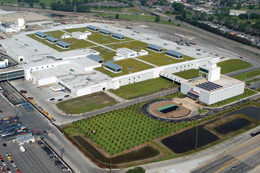
A scramble seems to be on to claim green superlatives. The world’s largest “living roof” sits atop Ford’s overhauled Rouge Center River plant in Dearborn, Michigan. Greenery helps soak up rainwater, which reduces problems with dirty water pouring off the roof, down drains, and ultimately out to rivers and lakes.
Chicago City Hall features the country’s first rooftop garden on a municipal building. Several major U.S. cities have followed suit, including New York, Toronto and Portland, where incentive programs have added thousands of acres of “green roofs.” A temple in Evanston, Illinois, the Jewish Reconstructionist Congregation, hopes its plans for a new solar-lighted home with salvaged brick and low-flow toilets will make it the nation’s first certified green synagogue.
The nation’s first certified green convenience store is The Pantry Inc.’s Kangaroo store, which opened in October near the University of Florida in Gainesville. It cost 15 percent more to build, but chairman and CEO Peter Sodini says, “Our payback should be quick because we will be using 25 percent less energy than a conventionally built store.” The world’s first LEED-certified supermarket is Giant Eagle in Brunswick, Ohio, where a wetland helps soak up runoff.
At the stylish Orchard Garden Hotel in San Francisco—which last July became California’s first LEED-certified hotel—energy use is expected to drop by one-fifth now that guests must insert a key card into a wall slot to turn on lights or the A/C. When the card is removed, power turns off, except for an outlet to charge laptops and cell phones.
The claim to be New York City’s first green office tower has yet to be decided. Seven World Trade Center declared itself just that in March, but six months later Hearst Corporation made the same claim for its new Hearst Tower. “Here is the deal,” explained Taryn Holowka, a spokesperson for USGBC, which certified the green buildings. “Seven World Trade Center was certified LEED as ‘core and shell,’ a version of LEED. The Hearst Tower is LEED-certified as a ‘new construction.’ The difference is that Hearst is occupying the whole building itself—so the company certified all of it—whereas 7 WTC isn’t occupying it all. So the core—shell, walls, floors and more—were certified as LEED. When tenants move in and build out the floors and suites, they can do LEED if they want as a ‘commercial interior.’ Or, do whatever they would like with it. Does that make sense?” Suffice it to say, green building has a growing cachet.
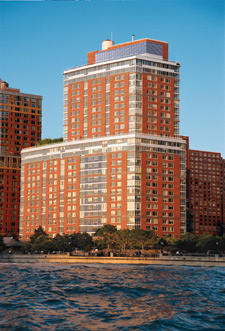
Greening the American Dream
Steven Glenn lives in “The Greenest House on The Planet,” as a Business Week headline called the glass-filled, two-story, four-bedroom, 2,500-square-foot prefabricated house designed by Ray Kappe and situated on a hillside street in Santa Monica, California. In this case, it’s an unwanted superlative.
“Well, it’s not true,” says Glenn. “We don’t write the headlines. What does that mean, ‘greenest house’? There are clearly homes that have a smaller ecological footprint than this one. But it’s much, much, much smaller than typical homes. So that’s a good point.”
You can, in fact, live in a home just like Glenn’s—he’s selling prefabricated versions of the first home in the nation to receive the highest-possible Platinum rating from LEED. His company, LivingHomes, is considered the first to make LEED-certified prefab homes available to consumers nationwide, though the cost is steep at about $300 per square foot. Glenn’s home serves as the model home. Just the building and foundation cost more than $1 million.
It’s a zero-energy house, with rooftop photovoltaic cells producing power that feeds into the electric grid by day, turning his electric meter backwards; by night, the building uses power from the grid for about four or five hours. The goal is that on average, the energy use zeroes out.
Sink and shower water irrigates the landscaping. Among many other features, there’s a rooftop garden. All wood and millwork is Forest Stewardship Council-certified. The company’s clients include people who buy organic foods, drive Priuses, shop at Design Within Reach furniture and give money to the Natural Resources Defense Council (NRDC).
Stockton Williams, meanwhile, is on a mission to green the homes of people on the lower end of the tax bracket—people like cancer survivor Jan Bey. She moved into Seattle’s aforementioned Denny Park Apartments, built through a five-year, $555 million initiative known as Green Communities that seeks to build more than 8,500 homes for low-income people in 23 states.
Williams works for the effort—a partnership between his employer, Maryland-based Enterprise Community Partners, and such organizations as NRDC, Global Green USA and the American Institute of Architects. The initiative provides grants, financing, tax-credit equity and technical assistance to developers who meet specific green criteria to build affordable housing. The goal is to help transform the affordable housing industry so that sustainable development becomes mainstream. Already, upwards of 6,800 units have been built or started in little more than two years. The locations vary from Atlanta, Los Angeles and Philadelphia to rural Viking, Minnesota, and the beach town of Bonita Springs, Florida. Senior citizens find green homes at the Azotea Senior Apartments in Alamagordo, New Mexico.
“We really believe that sustainable development has to become mainstream,” says Williams, senior vice president of Enterprise. “It’s not an option. It’s a right and necessary thing, because the people stand to benefit so much from better buildings. A more energy-efficient home saves people money. A healthy indoor environment helps folks with weakened immune systems or young kids,” while “rundown conditions [elsewhere] can exacerbate asthma.”
Bey’s neighbors and other Green Communities residents earn incomes ranging from nothing to two times the poverty level. “They are the working poor: janitors, bus drivers and service workers,” Williams says. “So, a seemingly small difference in a utility bill or the ability to walk to transit to go to work can have a significant impact.”
William Johnson, 20, one of Bey’s neighbors, expresses relief that his three-month-old boy, Savonte, is unlikely to accidentally burn himself on the heater baseboards, which seem cool to the touch. They’re actually “water radiators,” whose heat comes from a central gas-fired boiler downstairs, explained Michele Wang, who designed the building as a project manager at Runberg Architecture Group. “It’s something that’s very modern,” Johnson said. “We feel like we finally moved up—a step up.”
Apartment buildings like Johnson’s are symbols. If affordable housing can be green, Enterprise’s Williams figures, “It sends a very strong message that other builders and other building types really have no excuse. If the places that the people with the least amount of resources call home can be sustainable and can do their part to fight global warming, then how can the buildings and the builders of market-rate homes and high-rate homes not do at least as well?”
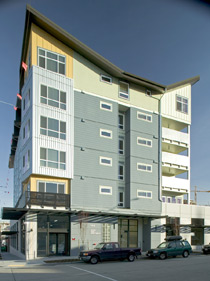
Obstacles
Not everyone is jumping on the green building bandwagon. Residential builders are slow to catch on to the trend, as they tend to look at what sold yesterday when deciding what to build today. Homebuilders mostly use the same means, methods and materials used 30 years ago, a report found. Architects and designers—important players behind the commercial greening movement—are rarely employed for homebuilding. Small companies build most houses, Browning says, so it’ll take a while for the green trend to filter down.
Resistance to change is perhaps to be expected, especially given typically higher building costs. But “the incredibly slow evolution of the building industry” is “a significant factor that holds back radical change,” according to a 2003 report by Duncan Prahl of Pittsburgh-based Integrated Building and Construction Solutions (IBACOS). “Very few builders are providing high-performance houses, so a consumer’s experience in a new home in terms of comfort, indoor air quality and durability are not markedly different today than they were a generation ago...[T]his is one key reason why many builders do not perceive customers demanding anything different.”
In fact, some limited focus groups indicate “consumers perceive green building to have a lower value that conventional construction.” Consumer preferences seem to veer in a planet-tromping direction, regardless of the pockets of green homes in cities like Austin, Portland and Denver. Case in point: the trend toward mega-sized houses, some of them outfitted with a full-body shower spraying more than 20 gallons of water per minute—enough to fill an entire bathtub in one minute.
“Every three people putting in these shower systems negates the efforts of 100 people putting in efficient products,” wrote Wilson, the BuildingGreen president, in Fine HomeBuilding magazine. Federal regulations require low-flow, 2.5-gallon-a-minute showerheads. Yet these new multiple-head systems spray 10 times as much or more, “a small portion of which may briefly contact your body,” Wilson wrote, “en route from your water heater to your sewer line.”
If the point behind the green building movement is to shrink every person’s footprint on the planet, then the societal shift toward 3,500-square-foot or larger homes runs counter to that spirit. The real estate world seems set up to encourage big houses—due to zoning regulations in some areas, subdivision covenants, mortgage lenders’ practices (a lot should not be worth more than 30 percent of the real estate, meaning a pricy lot needs a pricy building), as well as the usual desire by some consumers to keep up with the Joneses, according to a 1999 analysis published in Environmental Building News. The average house has doubled in size from about 1,100 square feet in the 1950s.
“You can build a pretty mediocre house from an energy standpoint at 1,200 square feet and it will probably use a lot less energy than a state-of-art green home that is 3,500 square feet. And that’s a factor we need to be conscious of,” Wilson says.
Building materials alone are gobbled up at a greater rate for bigger houses. It’s estimated that a 5,000-square-foot house consumes three times as much material as a 2,085-square-foot home, even though its square footage is only 2.4 times larger, according to that Environmental Building News analysis.
Green Mansions
Still, the green building movement includes green mansions—or as Salon.com dubbed them, “Great big green monster mansions.” LivingHomes, for instance, has been contracted to build 6,000-square-foot versions of Steven Glenn’s “greenest house on the planet.”
Most green-building rating systems don’t give much weight to house size. They don’t want to come across as proselytizers, Wilson says. So far, LEED has only a pilot project for rating homes, so the field is essentially left to other voluntary rating systems, all of which require buildings to gain a certain number of points to earn certification. The National Association of Home Builders’ Green Building Program addresses house size by awarding four points for building smaller, Wilson says, out of a 300-point rating system.
A notable exception was the Vermont Builds Greener certification system. If you wanted a certified-green home that’s twice the size of the average house, you had to earn 50 percent more points than would be required for a small home. And that meant adding far more eco-friendly measures to compensate. Since last year, however, the program has gotten more lenient, moving toward the LEED for Homes pilot standard, which requires 13 percent more points. (The hope, says VBG’s Peter Schneider, is that LEED will continue to incorporate more small-size-encouraging measures as its national standard evolves.) “We’re really trying to push people to build smaller homes,” Schneider says.
If the point is to be lighter on the planet, then the trend should be toward building smaller...or at least to shrink the energy bills of new, improved, green replacement buildings. But there’s a temptation to build bigger or more elaborately.
The glass-dominated, LEED Gold-certified Seattle City Hall stands out for such remarkable features as a lobby with cascading waters and a green roof, yet a local newspaper story bore this headline: “Seattle’s New City Hall is an Energy Hog.”
The building used 15 to 50 percent more electricity some months than the older, larger building it replaced, even though it houses fewer employees, said the Seattle Post-Intelligencer in 2005. Considering that Mayor Greg Nickels encourages mayors across the nation to cut their cities’ energy use to voluntarily meet Kyoto protocols, “the high energy use is an embarrassment for the city,” the P-I reported. Electricity use remains higher at City Hall than at the old building, though it’s unclear by how much, as officials sidestepped the question.
“The buildings are truly incomparable...We didn’t want another municipal building. We wanted a civic center,” says a defensive Brenda Bauer, director of Seattle’s fleets and facilities. “The electric use is higher because we’ve got many more functions. The efficiency of the appliances is extraordinarily more efficient. The lighting fixtures are more efficient. We had a building no one wanted to go in. There was nothing for people to do. It was seismically unsound and was, frankly, falling apart.”
Among things the new City Hall has that its predecessor didn’t: large lobbies and stairways, substantial fountains, a TV studio, specialty lighting for integrated art, architectural lighting on the exterior skin of the building and six efficient elevators. The building also has a greater number of ventilation fans and life safety systems, “all of which consume energy and create a more comfortable, safer and functional facility,” Bauer noted. “This is not in any way environmentally irresponsible.”
A study of LEED-certified buildings occupied for at least a year in Portland and Seattle found that six of the 10 buildings used an average of 30 percent less energy than predicted by design models, according to the Cascadia Region Green Building Council study. The bad news: Of the seven buildings that had design projections, all but one used an average of a third more water than predicted. Still, the average 25-year savings for the buildings studied is $2 per square foot.
Further objective examinations could help the green building movement spread. Some wonder whether efficiency standards really deliver desired results. “Clearly, it’s an extremely laudable goal. The question is: Is this laudable goal actually going to be reached in terms of performance and outcome by using the [building] techniques that are commonly used now?” says Ujjval Vyas, a former architecture professor and now an attorney with Foran, Glennon, Palandech & Ponzi, Chicago, which focuses on green building issues.
And historic preservationists and environmentalists want some consideration given to older properties. Around a ffourth of the material in solid waste facilities is construction debris, much of that from demolishing older and historic buildings.
When one typical small downtown building (25 feet wide by 120 feet deep) is demolished, it essentially wipes out the environmental benefit of recycling 1.34 million aluminum cans, argues Donovan D. Rypkema of PlaceEconomics in Washington, D.C., a speaker at the 2005 National Trust for Historic Preservation Conference in Portland. Every day over the past 30 years, an average of 577 older and historic homes are torn down. Typically built of the least-energy-consumptive of materials (plaster, concrete and timber), they’re often replaced with conventional buildings of energy-consumptive plastic, steel, vinyl and aluminum, he argued.
“You’re a fool or a fraud if you claim to be an environmentalist and yet you throw away historic buildings and their components,” Rypkema remarked.
While at least some green buildings make a deliberate point of using recycled materials, historic preservationists remain wary of bulldozers. “If a community did nothing but protect its historic neighborhoods it will have advanced every Smart Growth principle. Historic preservation is Smart Growth,” Rypkema says. “A Smart Growth approach that does not include historic preservation high on the agenda is stupid growth, period.”
In the end, it’s clear that the green building movement is growing, yet faces obstacles if it’s ever going to take the world by storm. Toronto-based designer Bruce Mau considers it vital. “For the first time in history, more than half the world’s population lives in cities. We’ll rebuild half the planet’s buildings in the next 50 years,” says Mau, keynote speaker at the Building Energy ‘05 conference in Boston. “Now that modern technology has put us in a position that we can do anything, what will we do?”
|
|
|
|